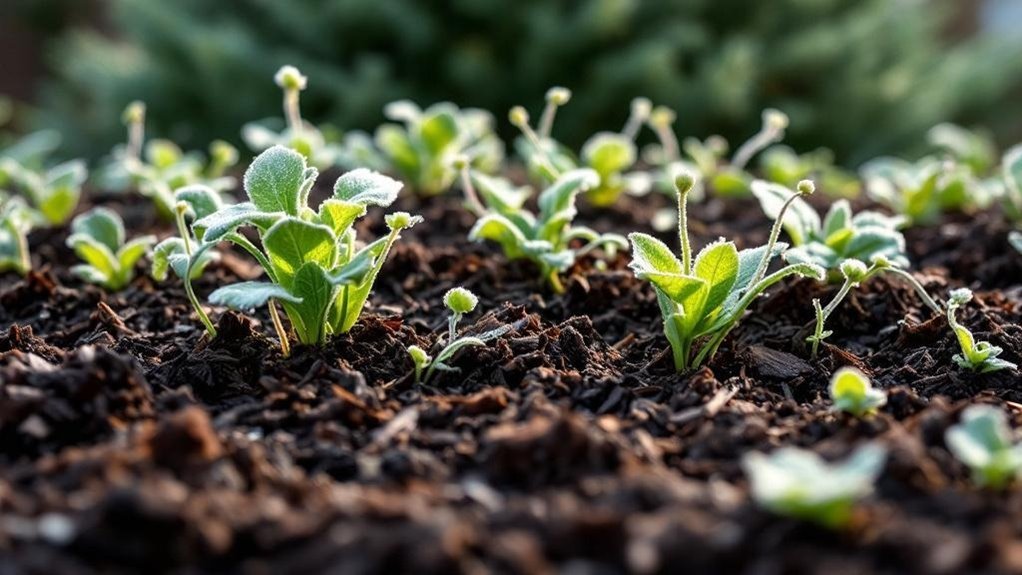Imagine your favorite tropical plant as a traveler braving a harsh winter storm without a coat. Without proper protection, tender plants can suffer damage or even perish when temperatures drop. You’ll want to learn how to shield these delicate greens effectively to help them survive the cold months ahead. Understanding the right methods can make all the difference between loss and lush growth come spring.
Reasons for Protecting Tender Plants in Winter
Because tender plants like tropicals and semi-tropicals can’t withstand cold temperatures, you need to protect them during winter to prevent fatal damage.
Tender tropical and semi-tropical plants require winter protection to survive freezing temperatures and avoid fatal damage.
These non-hardy plants lack the resilience to survive freezing conditions, making winter protection vital. Marginally hardy species, such as Japanese maples, also require shielding to endure extreme conditions without suffering winter damage to their stems and flowers.
Newly planted perennials are especially vulnerable; without proper care, winter damage can stunt their growth or kill them outright.
Overwintering helps you protect plants from harsh weather and browsing animals during snow cover, ensuring they thrive year after year.
Methods to Overwinter Tender Plants
When winter approaches, you’ll want to use a variety of methods to protect your tender plants from freezing temperatures.
For marginally hardy plants, apply loose mulch 6 to 18 inches deep after they enter a dormant state but before the soil freezes.
Indoor overwintering works well for tropical plants; place them in a cool place with air temperatures between 40-50°F, ensuring you water sparingly to avoid rot.
Lift tender perennials like dahlias, keep them just moist in a frost-free location, and check regularly for rot.
Build protective structures with breathable materials like burlap to shield plants while allowing air exchange.
For smaller tender plants, use cloches or plastic bottles, ventilating during the day and removing them once frost risk passes to maintain proper winter protection.
Using Mulch and Soil for Winter Insulation

Using mulch and soil effectively can provide vital insulation for your tender plants throughout winter.
Place a loose layer of mulch, like straw or shredded leaves, around the base of your plants once they enter dormancy, usually in early to mid-November. This mulch acts as protection, retaining heat and insulating roots from harsh temperatures. Aim for 6 to 18 inches deep but avoid compacting it, as good air circulation is important to prevent moisture buildup.
Secure the mulch with chicken wire to keep it in place during winter storms and heavy winds. This method reduces the risk of frost damage, especially for young perennials and grafted trees.
Remove mulch in early spring to allow plants to break dormancy and resume growth without being smothered.
Indoor and Structural Winter Protection
Although tender plants thrive outdoors during warmer months, they need special care to survive winter indoors or within protective structures.
Indoor overwintering suits tropical plants needing a stable environment between 60-70°F, while semi-tropical or dormant plants do well in cooler spots like an unheated garage or frost-free basement.
To protect your plants effectively:
- Use protective enclosures made from breathable materials such as burlap to guarantee good air circulation and prevent heat and moisture buildup.
- Regularly monitor moisture levels to prevent over-watering, especially for dormant plants that require less water.
- Store tubers and bulbs in breathable containers, checking often for rot to maintain plant health through winter.
Following these steps helps your plants survive frost and cold without damage.
Common Causes of Winter Plant Damage

Since tender plants aren’t adapted to cold, you risk severe damage or even death if you don’t protect them properly through winter. Vulnerable plants suffer from cold temperatures that can freeze root systems and cause crown rot when soil thaws. Frost heaving pushes roots and crowns back above the soil, exposing them to hard freeze injury. Moisture availability is critical; dry soil stresses plants, while excess wetness invites rot.
| Cause | Effect on Plants |
|---|---|
| Frost heaving | Exposes roots, increasing damage |
| Hard freeze | Freezes root systems, kills plants |
| Moisture issues | Leads to crown rot or drought stress |
Understanding these causes helps you prevent winter damage and keep your tender plants healthy through harsh conditions.
Frequently Asked Questions
How Do You Cover Tender Plants From Frost?
You cover tender plants from frost by using cloches, burlap, or old blankets. Make sure to vent covers during the day to prevent overheating, secure them against wind, and remove them once frost danger passes.
What Can I Use Instead of Fleece to Protect Plants?
Think of your plants as friends needing blankets—old sheets or blankets work great instead of fleece. You can also use plastic bottle cloches, burlap wraps, straw mulch, or chicken wire to shield them from frost and cold winds.
Is It Better to Cover Plants With Plastic or Cloth?
You’ll find cloth better than plastic because it lets plants breathe, preventing overheating and moisture buildup. Plastic traps humidity and causes temperature swings, stressing plants. Use cloth for insulation and remove covers on warm days to protect your plants.
How Do You Protect Potted Plants in the Winter?
You should move your potted plants indoors before frost, insulate pots with blankets, group them tightly, and use covers like cloches for warmth. Water sparingly indoors to avoid rot while keeping them cool and well-lit.
Final Thoughts
If you skip winter protection, your tender plants might as well be auditioning for a frozen disaster movie! Don’t let frost turn your garden into a frozen wasteland. By mulching deeply, bringing tropical beauties indoors, and shielding semi-tropicals properly, you’re basically giving your plants a cozy winter vacation. Follow these tips, and you’ll keep your plants thriving instead of turning into icy statues—because nobody wants a garden that looks like the North Pole!
